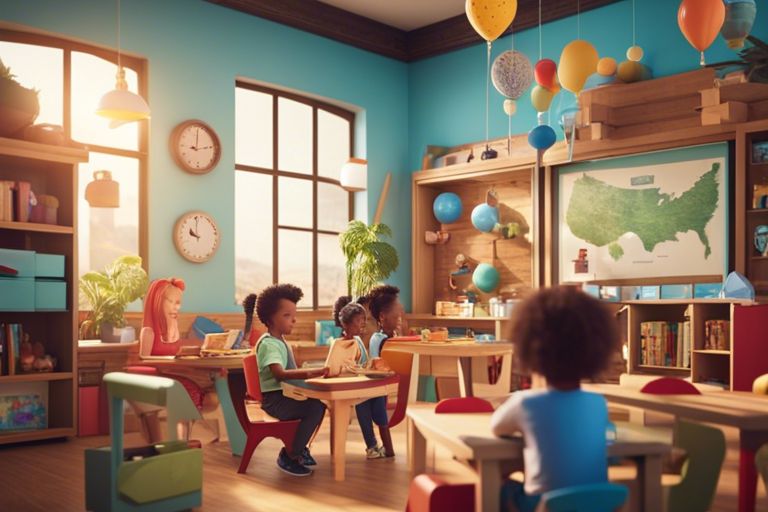Overwhelmed with the thought of making learning enjoyable for your child? Fear not! This guide is packed with 12 creative ideas to make learning both educational and entertaining for your little one. From interactive games to hands-on activities, we’ve got you covered with practical tips and tricks that will ignite your child’s curiosity and passion for learning. Say goodbye to boring study sessions and hello to a fun-filled learning experience that your child will love!
1. Use games or puzzles related to the subject.
2. Incorporate hands-on activities like science experiments or art projects.
3. Create a reward system or incentives for learning.
4. Take learning outdoors with nature walks or field trips.
5. Use technology like educational apps or online resources.
6. Encourage storytelling or role-playing to engage your child.
Setting the Stage for Fun Learning
Creating a Conducive Learning Environment
To ensure your child enjoys learning, it is important to create a conducive environment. This includes having a designated study area free from distractions, adequate lighting, comfortable seating, and necessary supplies such as books, pencils, and paper. A well-organized and welcoming space can motivate your child to engage in the learning process with enthusiasm.
Understanding Your Child’s Learning Preferences
With an understanding of your child’s learning preferences, you can tailor activities that cater to their strengths. Some children may learn best through hands-on activities, while others may prefer visual aids or auditory cues. Observing how your child responds to different learning styles can help you customize lessons to make them more engaging and effective.
Conducive learning environments and personalized teaching methods can significantly impact your child’s attitude towards learning. By creating a space that fosters focus and understanding your child’s unique learning preferences, you can set the stage for fun and effective learning experiences.
Creative Ideas to Spark Joy in Learning
Incorporating Play in Education
Learning through play is a powerful way to engage children in the learning process. Incorporating playful activities like educational games, role-playing scenarios, or hands-on experiments can make learning enjoyable and memorable. By tapping into a child’s natural inclination to play, educators can create a dynamic learning environment that fosters curiosity and creativity.

Utilizing Technology and Multimedia
An imperative aspect of modern education is the integration of technology and multimedia tools. Educational apps, interactive websites, videos, and virtual reality experiences can bring complex concepts to life and make learning more interactive and engaging for children. By leveraging technology, educators can cater to different learning styles and adapt to the digital preferences of today’s youth.
While technology can be a valuable tool, it is important to find a balance and ensure that screen time is monitored and used purposefully in the educational setting.
Practical Tips for Hands-On Learning Experiences
Despite the digital age we live in, hands-on learning experiences are invaluable for child development. These activities engage multiple senses and promote creativity and critical thinking skills.
Crafting and Art Projects
One great way to make learning fun for your child is through crafting and art projects. These activities allow children to express themselves creatively while improving their fine motor skills. Whether it’s painting, drawing, or creating collages, art projects provide a hands-on learning experience that can be both educational and enjoyable.
Science Experiments at Home
Practical science experiments at home can be a fantastic way to engage your child in hands-on learning. These experiments not only teach important scientific concepts but also help children develop their observation and critical thinking skills. With simple household items, you can conduct experiments that will spark your child’s curiosity and love for learning.
Experiments like creating a vinegar and baking soda volcano or growing crystals are not only fun but also educational. This hands-on approach to learning will make science exciting and accessible for your child. This practical experience will help them understand complex scientific principles in a simple and engaging way.
Interactive Learning Through Games
Educational Board and Card Games
Through educational board and card games, children can learn various skills such as critical thinking, problem-solving, and strategy development. Games like Scrabble, Monopoly, and Math Bingo can make learning math, language arts, and social studies more engaging and interactive for children. These games not only enhance academic knowledge but also improve cooperation, sportsmanship, and cognitive abilities in a fun and enjoyable way.
Gamifying Everyday Subjects
Little learners can benefit greatly from gamifying everyday subjects like counting, colors, and shapes. By incorporating interactive games and activities into daily routines, children can develop a strong foundation in basic concepts that will prepare them for more advanced learning later on. Simple games like scavenger hunts to find objects of different colors or shapes can make learning fun and exciting for young children.
Subjects like math, science, and language arts can be made more engaging for children by turning them into interactive games or challenges. For example, creating a treasure hunt where kids solve math problems to uncover clues, conducting science experiments with everyday household items, or playing word games to build vocabulary can all make learning more enjoyable and effective.
Outdoor and Experiential Learning
Nature Walks and Environmental Awareness
Many parents underestimate the power of nature walks in fostering their child’s curiosity and love for the environment. An afternoon spent exploring a local park or nature reserve can teach children about various plants, animals, and ecosystems. Encourage them to observe the intricate details of nature, such as different leaf shapes, bird calls, and insect behavior. This hands-on experience can instill a sense of environmental awareness and responsibility in your child.
Local Historical and Cultural Excursions
Now, let’s talk about how local historical and cultural excursions can add a dimension of learning and appreciation to your child’s life. Visiting museums, historical sites, or cultural festivals in your community can expose your child to diverse perspectives and traditions. These experiences can spark their interest in history, art, anthropology, and more. By immersing your child in different cultures and time periods, you are broadening their understanding of the world around them.
Outdoor learning experiences are not only enjoyable for children but also have a multitude of educational benefits. They help improve cognitive skills, enhance creativity, and promote physical activity. By incorporating outdoor and experiential learning into your child’s education, you are nurturing their holistic development and fostering a lifelong love for learning.
Encouraging Self-Directed Learning
Guiding Your Child to Set Learning Goals
While children thrive on structured activities and guidance, allowing them to set their own learning goals can be incredibly empowering. Encourage your child to think about what they want to achieve and how they can work towards it. This could be anything from learning a new skill, reaching a certain reading level, or mastering a particular subject.
Fostering a Love for Reading and Research
The key to fostering a love for reading and research in your child is to make it a fun and engaging experience. Introduce them to a variety of genres and topics, and let them choose what interests them. Create a cozy reading nook in your home, with plenty of books and resources readily available. Encourage your child to ask questions and seek out answers through reading and research.
Learning to love reading and research fosters a lifelong passion for learning and empowers your child to become curious, independent learners. By providing them with the tools and resources they need to explore different topics and ideas, you are setting them up for success both academically and personally.
Involvement and Support in Your Child’s Learning
Participating in Child’s Learning Activities
Learning becomes more engaging and effective when parents actively participate in their child’s educational pursuits. Whether it’s helping with homework, engaging in educational games, or reading together, your involvement shows your child that learning is a priority and can be a fun, family activity.
Providing Positive Feedback and Incentives
With positive reinforcement and incentives, you can motivate your child to excel in their learning journey. Praise their efforts, celebrate small achievements, and provide rewards for reaching milestones. By acknowledging their progress and offering incentives, you can boost their confidence and keep them motivated.
This type of positive feedback reinforces the idea that learning is rewarding and encourages your child to stay committed to their educational goals. Be specific in your praise, focusing on the effort they put into their work rather than just the end result. Incentives can be simple, such as extra playtime or a small treat, to keep the excitement and motivation high.
The Role of Social Learning
Learning Through Observation and Imitation
Keep in mind that children learn a great deal through observation and imitation. As a parent or caregiver, your actions and behaviors serve as a model for your child to follow. Encourage positive behaviors and provide a good example for them to emulate. This form of social learning can be very powerful in shaping your child’s development and understanding of the world around them.
Group Activities and Cooperative Learning
Assuming a facilitator role in group activities and promoting cooperative learning among children can enhance their social skills and foster a sense of teamwork. Group activities provide opportunities for children to interact with peers, share ideas, and work together towards a common goal. This type of collaborative learning can also help children develop vital communication skills and improve their ability to work effectively in a team setting.
Learning through social interactions is a fundamental aspect of a child’s development. By providing opportunities for your child to engage in group activities and cooperative learning experiences, you are not only supporting their academic growth but also helping them cultivate important social and emotional skills that will benefit them in various aspects of their lives.
Adapting to Challenges and Special Considerations
Special Consideration: Tailoring Learning for Different Abilities
Once again, parents may encounter challenges when their child has different learning abilities. It is crucial to tailor learning activities to fit your child’s unique strengths and weaknesses. By providing opportunities for success at their level, you can boost their confidence and motivation to learn.
Little Consideration: Overcoming Obstacles in the Learning Process
Special attention should be given to overcoming obstacles that may hinder the learning process. It is important to identify these obstacles early on and work with your child to find solutions. Whether it’s a learning disability, attention issues, or language barriers, addressing these challenges head-on can lead to a more effective learning experience.
Process: For example, if your child struggles with reading due to dyslexia, consider using audiobooks or interactive reading apps to make the learning process more engaging and accessible. Additionally, providing extra support or seeking assistance from professionals such as tutors or therapists can help your child navigate these obstacles and achieve their full potential.
Summing up
Now, you have learned 12 creative ideas on how to make learning fun for your child. By incorporating play, exploration, and creativity into their educational experience, you can help your child develop a love for learning that will last a lifetime. Remember to tailor activities to your child’s interests, abilities, and learning style to truly make the most of each learning opportunity. Keep the learning environment positive, engaging, and interactive to inspire your child’s curiosity and foster a growth mindset. With these strategies in place, you can create an enriching and enjoyable learning journey for your child.
FAQ
Q: Why is it important to make learning fun for your child?
A: Making learning fun for your child helps to enhance their engagement, motivation, and retention of information. When children enjoy the learning process, they are more likely to develop a positive attitude towards education and be eager to explore new topics.
Q: How can I make learning fun for my child?
A: There are several creative ideas you can incorporate to make learning fun for your child, such as gamifying lessons, using hands-on activities, integrating technology, incorporating arts and crafts, going on educational field trips, organizing educational games, setting up a cozy reading nook, encouraging role-playing, having a themed study day, involving outdoor activities, creating a reward system, and engaging in experiential learning.
Q: What are the benefits of making learning fun for my child?
A: Making learning fun for your child not only improves their academic performance but also fosters a love for learning that can last a lifetime. It helps boost their creativity, critical thinking skills, problem-solving abilities, social skills, and overall confidence. Additionally, it strengthens the parent-child bond and makes the learning journey enjoyable for both parties.




